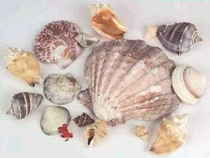
Texas Symbols
Texas State Shell
Lightning Whelk

(Busycon perversum pulleyi)
Adopted on April 22, 1987.
The lightning whelk, (Busycon perversum pulleyi,) was named the official state shell by the 70th Legislature iwhen Governor Bill Clements signed House Concurrent Resolution No. 75 on April 14, 1987.
One of the few shells that open on the left side, the lightning whelk is named for its colored stripes. It is found only on the Gulf Coast.
Texas State Shell: Lightning Whelk

Most often, these whelks eat clams--usually one a month. With its large foot, the whelk pries open the clam's shell. Then, with the clam shell held open by the edge of its own shell, the whelk sends its proboscis and toothed, tongue-like radula inside to rasp and eat the softer "meat."
The late Mildred Tate (1990) succeeded in championing the lightning whelk. Tate was born in Oklahoma and moved to Brazosport, Texas in 1951. There
she became interested in conchology, the study of "seashells" while visiting local beaches.
In 1960 Tate formed the first shell club in the area and was later one of the founders of the Brazosport Museum of Natural Science. She also served
as the museum's curator of malacology. (malacology - study of hard-shelled mollusks in its entirety)
At the age of seventy, Tate began her state shell quest, and on May 13, 1986, she discussed her dream with several Texas legislators at a Coastal Rehabilitation
meeting.
Tate chose a subspecies known as the "Texas lightning whelk." One of the few shells that open on the left side, the lightning whelk is named for its
colored stripes.
There is a bit of controversy surrounding the scientific name of this shell. Originally known as Busycon contrarium (Conrad, 1840), the name change
was proposed by Dr. Solomon Hollister in his 1958 treatise, and has been adapted with varying degrees of acceptance, depending upon the sources you
choose to consult.
The Texas lightning whelk received its scientific name in 1958 from Dr. S.C. Hollistere. The subspecies name, pulleyi, honors the late Dr. T.E.
Pulley, former director of the Houston Museum who furnished shells from the Texas' coast for Hollister to study.
Now that she had a promising candidate, Mildred Tate then asked other Texas shell clubs for support.
The state shell resolution was presented to the legislature in 1987 by Representative John Willy, who pointed out that the bluebonnet represents Texas'
plains and flatlands, the topaz its mountains. "It is fitting we name the lightning whelk the official seashell to represent the coastal areas of the
state," he said. Also, people also thought an official state shell might help promote tourism in Texas.
The Texas lightning whelk was approved by the Texas Senate and House. Governor Bill Clements signed the state shell bill on April 22, 1987. He was
presented with a beautiful lightning whelk.
In 1988, Mildred Tate was named Brazosport's Outstanding Woman, and a Smithsonian staff member commented, "She has done more than anyone else in this
part of Texas to encourage the study of conchology, not only as a hobby, but also as a science."
Texas House Concurrent Resolution No. 75
House Concurrent Resolution No. 75, 70th Legislature, Regular Session (1987)
House Concurrent Resolution (No. 75)
WHEREAS, The State of Texas has traditionally recognized certain terrestrial forms indigenous to the state as official state symbols; and
WHEREAS, The bluebonnet, the pecan tree, the mockingbird, the topaz, and the palmwood are examples of some natural specimens that serve to symbolize
the rich diversity of the plains, forests, skies, and mountains of our vast state; and
WHEREAS, in keeping with this custom, the designation of the Lightning Whelk as the State Shell of Texas will provide suitable recognition for the
beautiful beaches and inlets of our Gulf Coast region; and
WHEREAS, Texas' coastlands, bays, and tidal flats provide a total of 634 miles of valuable natural resources and recreation areas, attracting thousands
of visitors annually to this lush locality; and
WHEREAS, The Lightning Whelk, Busycon perversum pulleyi, is one of the most attractive and plentiful of the many shells lining our lovely beaches;
and
WHEREAS, Found only along the West Coast of the Gulf of Mexico, the Lightning Whelk received its Latin name in honor of the late Dr. T.E. Pulley, a
well-known Texas naturalist and teacher; and
WHEREAS, Of approximately 100,000 varieties of shells worldwide, the Lightning Whelk is the best known and one of the very few shells that normally
opens on its left side; and
WHEREAS, This delicately sculptured specimen recently received national recognition when it was selected to appear on one of the first shell stamps
ever printed by the United States Postal Service; and
WHEREAS, As enchanging as it is unique, the Lightning Whelk is the ideal choice for a state shell and will serve as a fitting emblem for the exceptional
beauty of the Texas Gulf Coast region; now, therefore, be it
RESOLVED, That the 70th Legislature of the State of Texas hereby designate the Lightning Whelk, Busycon perversum pulleyi, as the State Shell of Texas.
Adopted by the House and Senate 4/2/87, Approved 4/22/87
Taxonomic Hierarchy: Lightning Whelk
Kingdom: Animalia
Phylum: Mollusca
Class: Gastropoda
Order: Neogastropoda
SuperFamily: Muridadea
Family: Melongenidae
Genus: Busycon
Species: Busycon Perversum
SubSpecies: Pulleyi







